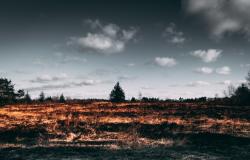The Ruddiman Hypothesis: A Debated Theory Progresses Along Interdisciplinary Lines

Scientist William Ruddiman is the lead proponent of the Early Anthropocene Hypothesis, which asserts pre-industrial land clearing and agricultural practices caused the release of historically underappreciated amounts of greenhouse gases, transforming the Earth. While Ruddiman’s hypothesis has engendered debate, a recent interglacial-ice age study and interdisciplinary archaeological investigations add nuanced support to Ruddiman’s effort and illuminate how humans have impacted the biosphere over thousands of years. In an interesting twist to this debate, these recent land clearing studies offer a clarifying, long-term context for natural solutions for the climate crises by highlighting the Earth’s regrowth potential.
In the 1990s marine geologist and current University of Virginia emeritus professor William Ruddiman participated in the summer gatherings of the Cooperative Holocene Mapping Project (COHMAP), which focused on Earth’s conditions beginning around 20,000 years ago during the last glacial period and continuing on into the present interglacial Holocene that began around 12,000 years ago. In COHMAP, Ruddiman interfaced with pollen experts, climate scientists, and others who specialized on the Holocene.
Around the time COHMAP wrapped up, a substantial Antarctic ice record detailing past atmosphere composition came out, showing high methane concentrations ten thousand years ago and decreasing steadily for a few thousand years. The record indicated that around 6000 years ago, atmospheric methane and carbon dioxide rebounded and rose in concentration, instead of expectedly declining, given the Earth’s orientation in the solar system – its “orbital” configuration – that shapes the Earth’s temperature and carbon and methane geochemistry.
Shortly thereafter, Antarctic ice core data from earlier interglacials started coming in, and Ruddiman noted that in previous interglacials methane and carbon dioxide trends kept going down. “It seemed obvious to me that this interglacial was anomalous. And the only thing I could think of was that it might be humans.”
Expanding his focus, Ruddiman began developing his hypothesis that it was primarily humans’ forest clearing for agriculture that released carbon dioxide and methane-emitting rice cultivation that accounted for the upward spike in greenhouse gases emissions before modern times.
Some climate scientists, especially geochemists like the well-known Wally Broecker -- objected to Ruddiman’s explanation and claimed that geochemical ocean dynamics caused the unexplained rise in the carbon release. Importantly, Broecker and others claimed that the Stage 11 Interglacial was the best analogue to the Holocene and its comparison did not support Ruddiman’s claim. The objectors also held that before the 19th century, the less numerous humans could not have massively cleared forests with the carbon impacts Ruddiman suggested (see here; and for background on debate in media and science, see Richard Blaustein’s 2015 article).
But in recent years that is what ecologists, botanists, and archaeologists have been establishing – massive and early preindustrial deforestation. Moreover, archaeobotanists, prominently Dorian Fuller of University College London, have documented the large expansion of rice patty agriculture thousands of years ago, explicating the methane rise. And offering strong support for the Ruddiman hypothesis, a consortium of over 250 archaeologists published a well-noted August 2019 Science article, “Archaeology assessment reveals Earth’s early transformation through land use,” that posited “a planet largely transformed by hunter-gatherers, farmers and pastoralists by 3000 years ago.” (Stephens et al., 2019)
It was in 2018 and the end of 2017 that Ruddiman’s hypothesis was most pointedly bolstered: a 2018 study identifying a pre-Stage 11 interglacial as the best analogue for the Holocene (thereby shedding light on human impact since the dawn of agriculture), a 2018 pollen-based study of historical deforestation -- and published research estimating global biomass potential and historical loss first published online in late 2017 together lent weighty support for Ruddiman’s argument.
Moreover, the global biomass and historical deforestation research led to a new connection for the Early Anthropocene argument. Ruddiman and ecologists point out that these recent studies indicate real carbon dioxide mitigation opportunities in this era of the Paris Agreement: the planet’s immense historical biomass capacity, they say, profoundly underscores that improving land management could enable natural terrestrial processes to draw down carbon at a significant scale.
As we ready for strengthening Paris Agreement with the November 2021 Glasgow Climate Summit, the Ruddiman hypothesis thus provides deep-time parameters and human historical context for restoration natural solutions that are being advanced in the lead up to the November meeting. And this latest advance phase of the Ruddiman hypothesis reveals a nexus between understanding the Earth’s historical geochemistry, contemporary mitigation solutions, and the archaeological quest to understand how humans have impacted the Earth. It is fascinating but not so surprising that our species would have such an impact on biomass and biosphere,” reflects Ruth DeFries, Columbia University professor of sustainable development, who is not affiliated with the recent studies. “Ruddiman’s hypothesis that humans have had an impact on climate long before the industrial revolution – millennia before – is part of a larger picture of how we are part of the biosphere and always have been part of the biosphere, using it for our own purposes and impacting it.”
Finding the best interglacial analogue
University of Wisconsin climate scientist and modeler Steve Vavrus has modelled the land use greenhouse gas impacts during the early Holocene, and recently led a study examining Marine Isotope Stage 19 (MIS19), an interglacial period around 770,000 years ago, which has emerged as the best Holocene analogue (Vavrus et al. 2018). Inputting the Earth’s orbital factors and atmospheric gas levels as indicated by ice core data, Vavrus’s effort demonstrated via a supercomputer simulation that glacial increase occurred in northern Canada and Russia at a MIS19 time analogous to the Holocene’s greenhouse gas upturn, indicating a “glacial inception” for our geological epoch if not for early anthropogenic greenhouse gas emissions.
Scientists earlier held that the Marine Isotope Stage 11 (MIS11) interglacial that occurred from 424,000 and 374,000 years ago as the best Holocene analogue. Ruddiman disagreed as early as 2005, saying it mismatched with the Holocene’s complete orbital configuration – which is made up of “eccentricity” (the Earth’s rotation around the sun), its “obliquity” (the Earth’s tilt axis); and “precession” (the Earth’s wobble on the axis). In particular, the Stage 11 obliquity does not match up to the Holocene pattern by thousands of years.
Over time, more ice data and glacial-interglacial time refinements came out, and making use of this more precise data, Steve Vavrus and colleagues (2018) underscore a current appreciation of that Stage 19 is a better analogue than Stage 11. In addition to Vavrus, Ruddiman points to the work of University College London palaeogeographer Polychronis Tzedakis, who, along with Ruddiman was a co-author on Vavrus’s Scientific Reports paper, as particularly important for clarifying the interglacial past and MIS19.
Comparing the MIS19 conditions that would match with 1850 in the Holocene, Vavrus’s 2018 Scientific Reports s paper states: “The mean-annual global temperature falls by 1.27 K while the 5-6 K cooling in the high Arctic is the most pronounced anywhere.” While the Earth would not have had another ice age, in the Holocene absent an early greenhouse gas upturn, a year-round “glacial inception” would have set in parts of Canada and Russia that today are snowed over seasonally.
Ruddiman and Vavrus highlight different but complementary aspects of the Vavrus-led study. “We now have six or seven previous interglaciations to look at the carbon dioxide trends and all of those must have been natural – humans were not an active force on the land,” Ruddiman says. “And none of those previous interglaciations show any kind of rising trend like what is happening in past 7000 years. In my mind, the record from the natural previous interglaciations rules out any natural explanation for the rise in carbon dioxide in this interglaciation.”
Vavrus highlights that the simulation’s outcomes have the same ultimate portent to which his earlier research points. “The argument that a few numbers of humans had a huge impact on the environment – if that is true, and our evidence suggests that it is – is all the more reason to be concerned about the much bigger impact we are having on the present-day environment with so many more people in the world and the amount of carbon emissions much higher in the present,” Vavrus says.
The once-robust forests of Europe
Forest clearing is central for the Ruddiman hypothesis, and while ecologists and botanists have used pollen for decades to recreate past land changes, new computational capacities and modelling have greatly expanded their research for historical forest clearing.
University of Plymouth paleoecologist Jesse Woodbridge carried out the data synthesis for "Europe's Lost Forests: a pollen-based synthesis for the last 11,000 years," the 2018 Scientific Reports paper that combined three advanced pollen-land use models and demonstrated large scale forest clearing in Europe going back thousands of years (Roberts et al. 2018).
“This is the first reconstruction for Europe at this level of detail,” says Woodbridge, who stresses that all this work is underpinned by availability of large databases, such as the European Pollen Database that amalgamates decades of contributions from hundreds of pollen experts.
The study found that Europe forest cover peaked 8,000-6,000 years ago, and that forests then covered around three quarters of Europe. Shortly after 6,000 years ago, significant deforestation began. The northern Europe needle-leaf forests persisted further in time, while deciduous forests in mid-latitude western Europe were felled in earnest for agriculture early, beginning around 6000 years ago. By 3,000 years ago, quite extensive European deforestation had taken place. Today, fragmented forests cover less than half of Europe. Woodbridge and colleagues offer that most forest losses occurred before the industrial revolution.
Ruddiman adds that while “Europe’s Lost Forests” covers Europe and is not a global estimate, it is complemented by much research in China with 50,000 archaeological communal sites that point to enormous population increases 8,000 to 4,000 years ago, indicating deforestation. “Since these people are farmers, and we are talking about areas of natural forests, they had to clear those forests to get the sunlight to the land so they could grow crops.” Ruddiman gives a rough estimate that Europe and China combined account for roughly a preindustrial removal of 45% of natural forest.
Woodbridge and co-authors participate in the international PAGES collaboration (Past Global Changes) that is working on producing globally comprehensive land cover maps to help climate modelers and others understand the past and assess future land-based opportunities. Woodbridge stresses regional and global research is ongoing, but she says, “‘Europe’s Lost Forests’ doesn’t prove William Ruddiman’s work, but it makes it difficult to ignore the early farming greenhouse gas impacts over the last 3,000 years.”
Global biomass, yesterday, today, and tomorrow
"Unexpectedly large impact of forest management and vegetation on global biomass," (Erb et al. 2018), ties in even more directly with Ruddiman’s carbon release estimates. Lead author and socioecologist Karlheinz Erb of Vienna’s University of Natural Resources and Life Sciences, says he and colleagues encountered significant baseline data gaps for their work on the human ecological imprint. The gaps were critical not only for their work but also broader carbon cycle estimates, such as those of the Intergovernmental Panel on Climate Change (IPCC).
Matching different models, surveying literature and gathering remote sensing data, Erb’s group came up with estimates for global potential biomass estimate around 916 gigatons (Gt) and current global biomass at 450 Gt. According to Erb, the finding that potential carbon stocks are halved, “which is much too large for only the industrial emissions,” points toward Ruddiman’s ideas. Of the gap of 466 Gt, Erb offers around 310 Gt came from preindustrial impacts, nearly identical with Ruddiman’s published estimates. The paper details a 115–425 Gt preindustrial range given terrestrial fluxes, but with a solid 140 Gt from industrial age land use emissions, a 310 Gt is a good average, according to Erb.
Erb says some of the gap of past and present global biomass could be hid in what is known at the residual terrestrial carbon sink, such as in peatlands. However, the mostly likely explanation is the Ruddiman hypothesis. “We can provide a certain indication that at least somehow Ruddiman was right,” Erb says.
Equally, the Erb paper underscores that the potential-actual biomass gap indicates a huge potential to naturally sequester carbon. However, Erb cautions that there are important trade-offs and rights considerations to take account – such as indigenous peoples’ ownership of forests. And the paper emphasizes that “[t]he difference between actual and potential biomass stocks can be interpreted as the upper boundary of the carbon-sequestration potential of terrestrial vegetation.” Explicating the outside potential, DeFries says, “Given how civilization has evolved, it is impossible to recoup all the biomass at this point when we have seven billion people to feed and a few more billion on the way.”
Nonetheless, Erb and colleagues highlight that restoring and conserving lands, especially forest stocks, has great potential. Of the biomass gap, deforestation causes 53-58%; and 42-47% of total gap comes from land management, especially for forests but also for grazing lands, that could be changed. Erb highlights that with four-fifths of the forests currently managed and with approximately one-quarter to one-third reduced biomass, conservation adjustments in this sector, along with some reforestation, could quickly lead to progress toward the Paris Agreement goal of limiting global warming to a 1.5 C increase relative to pre-industrial temperature. “We will build up very quickly biomass stocks which will be a very strong signal of restoring carbon from the atmosphere,” Erb says. In fact, since the 2018 publication of "Unexpectedly large impact of forest management and vegetation on global biomass,” a recent October 2020 Proceedings of the National Academies (PNAS) article that focuses on U.S. forests supports Erb’s highlighting of enhanced managed forests, stating that replenishing understocked coterminous U.S. managed forests could increase U.S. forest sequestration up to 20 % (Domke et al. 2020).
Open questions
Woodwell Climate Research scientist Richard Houghton, an expert on the global carbon budget, also feels Erb’s extension of Ruddiman’s historical approach has promise for mitigation. Houghton is not a participant in the Ruddiman discourse, and while he understands humans have been altering landscapes for thousands of years lowering carbon stocks in biomass, he believes carbon emissions in recent decades are unprecedently steep compared with very small annual pre-historic emissions that would not leave an atmospheric C02 signal. Moreover, he points out some open questions to consider. Houghton has recently modelled the impacts of fire and suppression on United States biomass historically and says natural fire might account for some vegetation gaps in the Ruddiman time frame. He would also like to see more about the vegetation differences that correlate with the different levels of atmospheric carbon dioxide, and that there is more to learn about the carbon residual.
However, Houghton does not doubt a substantial preindustrial human impact on the environment and that estimating past vegetation helps with understanding mitigation potential today. He also participated in a recent Woodwell Climate Research Center 500-meter resolution mapping of national landscapes for terrestrial sequestration potential, including soil, that was led by Dr. Wayne Walker, also at Woodwell Climate Research Center, set in the context of the nations’ Paris Accord Nationally Determined Contributions (NDCs) plans. Houghton says his group has come up with findings similar to Erb’s and adds "it is surprising how much in developing countries land use plays a role."
Interdisciplinary approach for climate history and today’s land use problems
DeFries feels that Ruddiman’s line of investigation underscores the importance interdisciplinary collaboration for finding mitigation applications, as well as historical estimates. “If the goal is to use our science to help think through the problems in the world—which include climate change and biodiversity loss and how to produce enough food for the population – we need to get beyond the particular tunnel of our own discipline and include all those science professions but also the social science and community aspects of understanding how people work and make decisions,” she says.
Ruddiman, too, sees his hypothesis’s present and future lines of work as a “beautiful example of convergence of different lines of science” both for biosphere understanding and now with mitigation pertinence. He adds that the tie-in of historical biomass, mitigation, and his work was an encouraging surprise. “The implication that Karlheinz Erb drew that there is a lot more potential to store carbon in land vegetation if we could let large amounts of it revert to a natural state, that’s to me the largest implication of my hypothesis, if you phrased the question what’s its importance for the future,” Ruddiman says.
Rich Blaustein is a freelance science, environmental and legal journalist based in Washington, DC. He has published in Physics World, Physics Today, BioScience, Washington Lawyer, Minding Nature and other publications.
Photo by Matthis Volquardsen from Pexels


